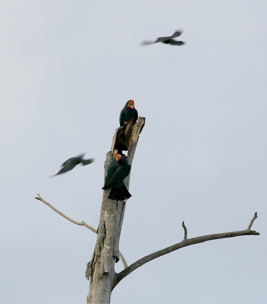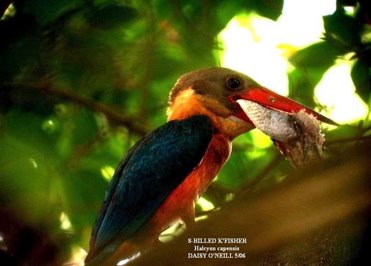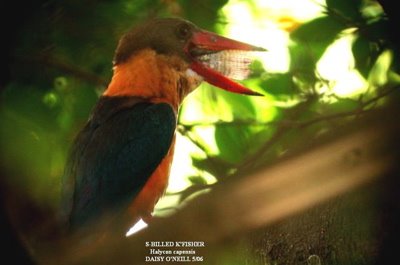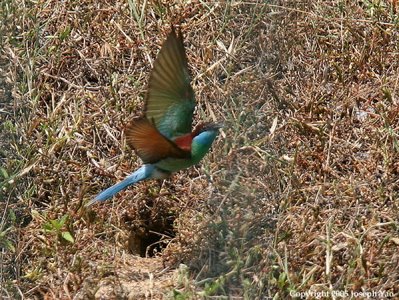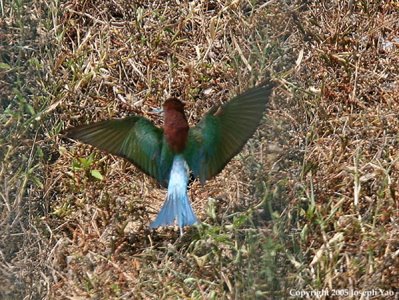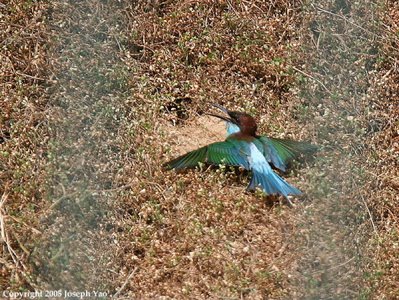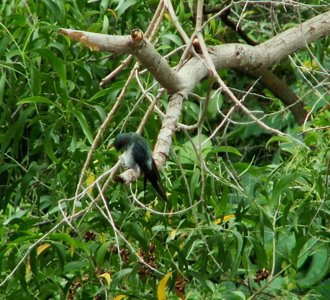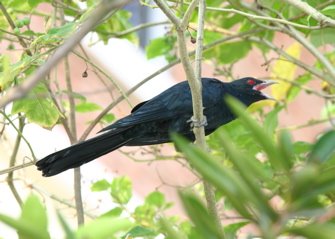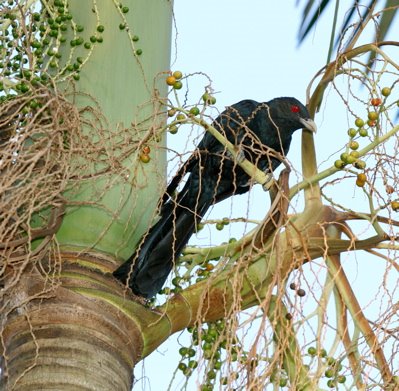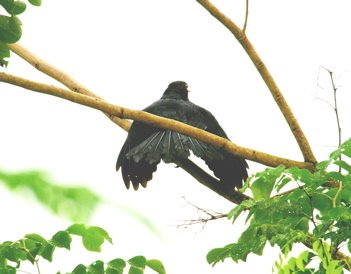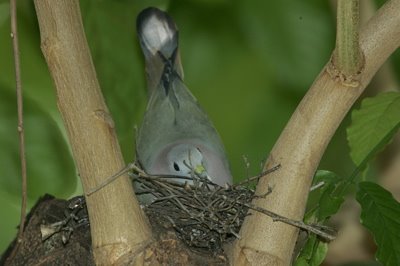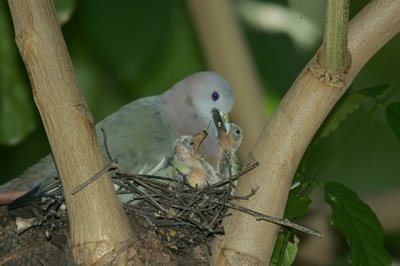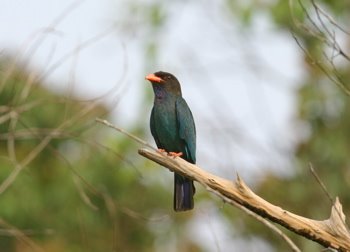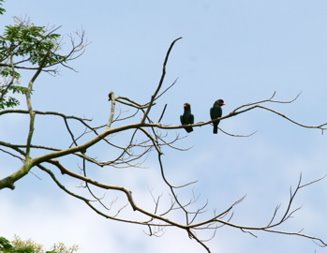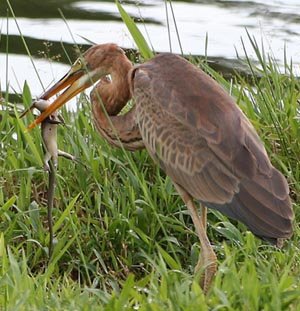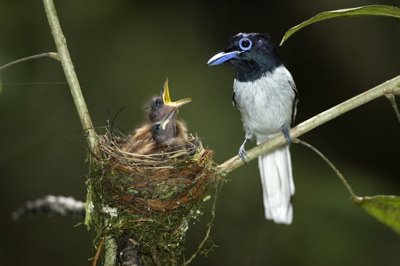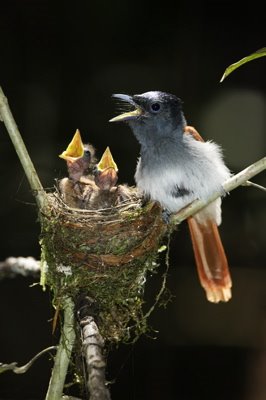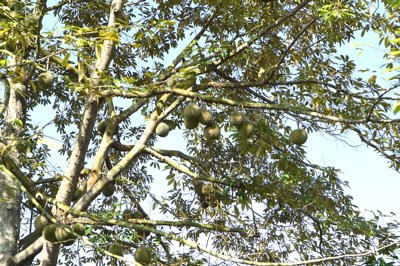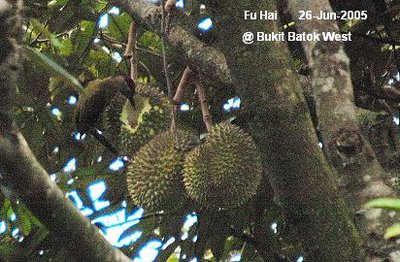A scheduled Saturday night of owling turned unforgettable for a birding trio.
With birder-photographer Chien, a budding Mike, and me dressed for the occasion, it was meant to be a night out putting our new toys - a night vision aid and my ‘third eye’ – headlights, to a test!
We were just about to call it a night after having seen the owls as hoped, but we decided to retrace our steps once more to the known site of the Mangrove Pitta (
Pitta megarhyncha) (see also
1, 2 on Blue-winged Pitta), to add more bird sightings to our owling list.
At this point, I would like to take readers back two months.

An adult pitta was sighted by me and photographed by Chien on 27th May 2006. It was our lifer of the very first pitta species and for the very first time sought after. It was the first time ever that such an elusive bird was captured on camera in that brevity of moment while picking nesting material. The bird flew towards the opposite direction from the nesting site as a decoy upon having seen us. There had been numerous confirmed sightings in the past by other birders but no photo opportunities were had prior to this day.
Stalking the Mangrove Pitta for the first time together on 27th May has been our ‘stepping stone’ of numerous good moments in bird-photography. We seem to have that incredible birding luck as a team.
For harnessing such good fortune together, I now present and share with you that moment with Chien and triple luck, young birder-photographer Mike.
I believe 30th July is to be one and one life time only opportunity to bear witness to this account – sighting a juvenile Mangrove Pitta at 12 midnight. It did not occur to us that this species that eludes so many birders in the daytime could be possibly seen at night and in deep slumber on a unique, open perch.
We crept single file along the short boardwalk beside the river and into total darkness under tree canopy of mixed banyan trees and nipah palms. Instinctively, my flashlight went searching for the floor coverings and subconsciously I was thinking wishfully and whispering aloud to Chien: “It would be a miracle to see a pitta at this time of the night!”
Chien chuckled in disbelief but knew I was not looking for owls but for an elusive hope of sighting a pitta - a chance in a million to ever see one that night.
That nice quiet feeling of unexplained euphoria rose to the challenge and continued to hang over me as I led the way with my searching flashlight. With birder Mike walking behind and charting new virtual birding horizons on ventured birding trips with us, he was elated.
Suddenly I saw a white object hanging in mid-air. We approached cautiously as there were numerous banyan roots hanging down from tree canopies as well as twisted stems of woody climbers dangling across. The white object appeared to be levitating from this dangling stem in the dark!
“It’s a pitta! Shh…….” Excitedly, I whispered to Mike who passed the message to Chien, birder-photographer cum bodyguard for the night.
We approached just in time to see this white object raised its head that snuggled, in an under-winged position to reveal its identity as a juvenile Mangrove Pitta.
This was a five weeks old juvenile with pinkish belly already showing. Earlier in the week the same chick was sighted in the morning. Now it was confirmed by three birders at night.

We stood on the boardwalk and stared silently at the juvenile in disbelief. We were stunned by the snoozing bird that was just perching on the stem like a trapeze artist. I cautiously waved my flashlight at the bird to observe for any response from it. The bird remained motionless in sleep mode and thus allowed some beautiful night photography pictures from Chien’s Nikon D200 and Mike’s Nikon D2H (DSLRs). My Nikon P4, toy by comparison, ‘also can’ showing the ‘Apparition Pitta’ on a ‘trapeze’ (above).
Chien could not believe that it was happening. Stalking a pitta in the day was difficult and sweaty enough. Having a pitta perched and posed in front of the camera for as long as he wanted was simply unimaginable and photographing one at midnight had to be a miracle. It happened!

There had been a couple of moments when the pitta yawned and scratched. Caught in action by Mike’s camera, it showed a crescent
nictitating membrane emerging from the inner corner of the eye (above).

Chien’s photo showed a ‘full moon’ nictitating membrane taken at the time when the pitta was scratching. Was that an involuntary reflex like when one walks and swings the other hand? (above).
Yawning action was captured with pitta’s eyes opened (below). Did the bird not see us? We were about 3 metres away! Doesn’t the bird see at night? Was it blinded by our flashlight? These were the questions that puzzled us.

We decided to put another observation to the test. From communication with initial hand signals to whispers that got louder and louder, we proceeded to speaking in normal tone and deliberated openly on the subject of ‘nictitating membrane’.
It was hard to believe that our presence and discussion went on until 1am and the bird was still perching on the same vine unperturbed by neither our voice nor presence.
The conclusion to this juvenile pitta’s behavior could be that, pittas do not see nor hear well in the dark as opposed to extreme acute sight and hearing in the daytime.
The innocent juvenile 5 week-old chick had not been exposed to human predatory presence nor acquired survival skills yet. Besides, the tide was high that night and the ground underneath the boardwalk was flooded. No escape for the juvenile but to play ‘stand and look dead’?
We left thanking and leaving the juvenile Mangrove Pitta the way we first sighted it - in sleep mode.
For us trio, we each went home with a great feeling that we had struck the national lottery. We took that euphoric feeling to bed. The juvenile Mangrove Pitta probably did not care and continued with sleep. We slept not.
Submitted By: DAISY O’NEILL, PENANG, MALAYSIA.
Images from top to bottom: Breeding Mangrove Pitta with nesting material by Tse Chien; 'Apparition' juvenile pitta on trapeze by Daisy O'Neill; Crescent nictitating membrane by Michael Ng; 'Full moon' nictitating membrane by Tse Chien; and Yawning Pitta by Tse Chien.
 How do birds deal with wastes generated by their nestlings? Those of the Peaceful Dove (Geopelia striata) seen on the left obviously do not practice sanitary hygiene, soiling their nest with their faeces.
How do birds deal with wastes generated by their nestlings? Those of the Peaceful Dove (Geopelia striata) seen on the left obviously do not practice sanitary hygiene, soiling their nest with their faeces.  Local birders have always been aware that certain species of birds dispose of the nestlings’ wastes via faecal sacs. The image above shows a female Scarlet-backed Flowerpecker (Dicaeum cruentatum) removing a faecal sac full of mistletoe seeds from a nestling. We take for granted that these sacs are disposed of some distance from the nests. But we should keep a look out on exactly where these sacs are disposed.
Local birders have always been aware that certain species of birds dispose of the nestlings’ wastes via faecal sacs. The image above shows a female Scarlet-backed Flowerpecker (Dicaeum cruentatum) removing a faecal sac full of mistletoe seeds from a nestling. We take for granted that these sacs are disposed of some distance from the nests. But we should keep a look out on exactly where these sacs are disposed.  In November 2004, Tang Hung Bun observed an off-season nesting by a pair of Scarlet-backed Flowerpeckers. He videoed the feeding and removal of the faecal sac which was extra large. This large sac contained green, undigested mistletoe seeds.
In November 2004, Tang Hung Bun observed an off-season nesting by a pair of Scarlet-backed Flowerpeckers. He videoed the feeding and removal of the faecal sac which was extra large. This large sac contained green, undigested mistletoe seeds.


